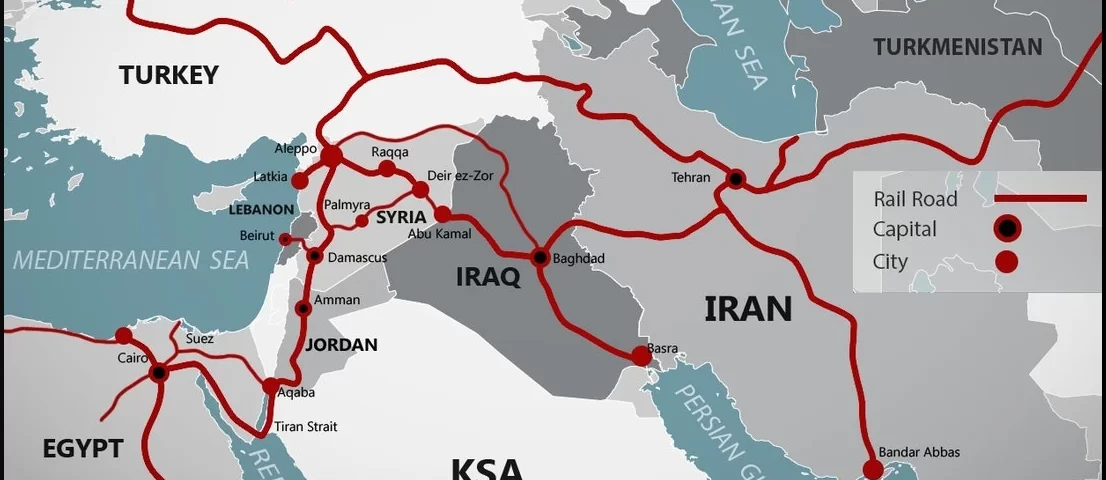by Matthew Ehret, published on Matthew Ehret’s Substack, December 9, 2021
Ever since Russia and China began challenging the Anglo-American scorched Earth doctrine in 2011 with their first vetoes against US intervention into Syria, the Gordian knots that have tied up the Arab world in chaos, division and ignorance for decades have finally begun to unravel.
Where just one decade ago the unipolar vision of the ‘new American century’ reigned unchallenged, by 2013 the Belt and Road Initiative (BRI) had sprung into life, and the largest purges of China’s deep state on record were launched under Xi Jinping’s watch. This latter crackdown even earned the ire of the American intelligence community, with war hawk John Bolton complaining that Xi’s authoritarianism has made the CIA job of maintaining its spies inside China nearly impossible.
This new operating system, tied closely to Russia’s Eurasian Economic Union, has grown in leaps and bounds. Today, a new multipolar future has emerged; one which plans to actually deliver long-term development for all those who choose to play by its rules.
One of these adherents will be Syria, which is re-emerging onto the world’s stage after having miraculously defended itself from a ten-year military onslaught launched by the old unipolar players.
Of course, the pain and destruction of the war is still deeply felt; illegal US sanctions continue to plague the hungry masses, prevent the reconstruction of basic infrastructure and access to potable water, and cripple schools, hospitals, businesses, and livelihoods.
The BRI and Syria’s new future
On 5 November, China’s President Xi Jinping spoke with Syrian President Bashar Al-Assad, saying “we welcome the Syrian side’s participation in the Belt and Road Initiative and Global Development Initiative” and calling for reconstruction, development, and the defense of Syria’s sovereignty and territorial integrity.
The discussion came in the wake of Chinese Foreign Minister Wang Yi’s whirlwind tour across West Asia and North Africa in July 2021, during which he met the Arab League’s chief to discuss Syria return to the fold.
By the end of this tour – which coincided with Assad’s re-election – China had signed a four-point proposal for solving Syria’s multifaceted crisis with a focus on large scale reconstruction, ending illegal sanctions and respecting Syria’s sovereignty.
Syria, in turn, re-affirmed its support for China’s territorial integrity in the face of western-sponsored separatist movements in Xinjiang, Tibet, Taiwan, and Hong Kong.
China’s interest in West Asian development was first made known in 2017 when Chinese foreign ministry spokesman Geng Shuang stated:
“Too many people in the Middle East are suffering at the brutal hands of terrorists. We support regional countries in forming synergy, consolidating the momentum of anti-terrorism and striving to restore regional stability and order. We support countries in the region in exploring a development path suited to their national conditions and are ready to share governance experience and jointly build the Belt and Road and promote peace and stability through common development.”
In 2018, China offered $28 billion in development aid to Syria while simultaneously coordinating the integration of Iraq into the BRI, made official in September 2019 when then-Prime Minister Adil Abdul Mahdi unveiled the China-Iraq oil-for-reconstruction program and Iraq’s broader integration into the BRI framework.
Events coordinated by foreign interests did not permit this momentum for long. Mass protests soon toppled Abdul Mahdi’s government and, with it, the oil-for-reconstruction initiative. While recent months have seen a revival of this initiative from Iraq in piecemeal form, progress has been slow.
Instead, the 25 year Comprehensive Strategic Partnership agreement struck between China and Iran in March 2021 has become the main gateway for extending Beijing’s infrastructure and connectivity projects into West Asia.
The construction of the Iran–Iraq Shalamcheh-Basra rail line is now underway, bringing the two neighboring states into an equal cooperative footing and opening prospects for greater rail and energy corridors extending from Iran through Iraq and into Syria, as a southern branch of the BRI.
In April 2019, Syria was invited to attend the first official BRI summit in Beijing, where President Assad stated:
“We have proposed around six projects to the Chinese government in line with the Belt and Road methodology and we are waiting to hear which project, or projects, will be in line with their thinking … I think when this infrastructure is developed, with time, the Silk Road (Belt and Road Initiative) passing through Syria becomes a foregone conclusion, because it is not a road you only draw on a map.”
So what, specifically, are those projects?
China and Syria are keeping their cards close to their chest when it comes to details for the moment. But it is not impossible to make some educated guesses about Assad’s wish-list by revisiting his earlier strategic vision for Syria.
Specifically, that would be the Five Seas Strategy that Assad had championed from 2004 to 2011, which disappeared from view once Syria was targeted for destruction.
Matthew Ehret is a Journalist, Artist and Senior Fellow of American University in Moscow
